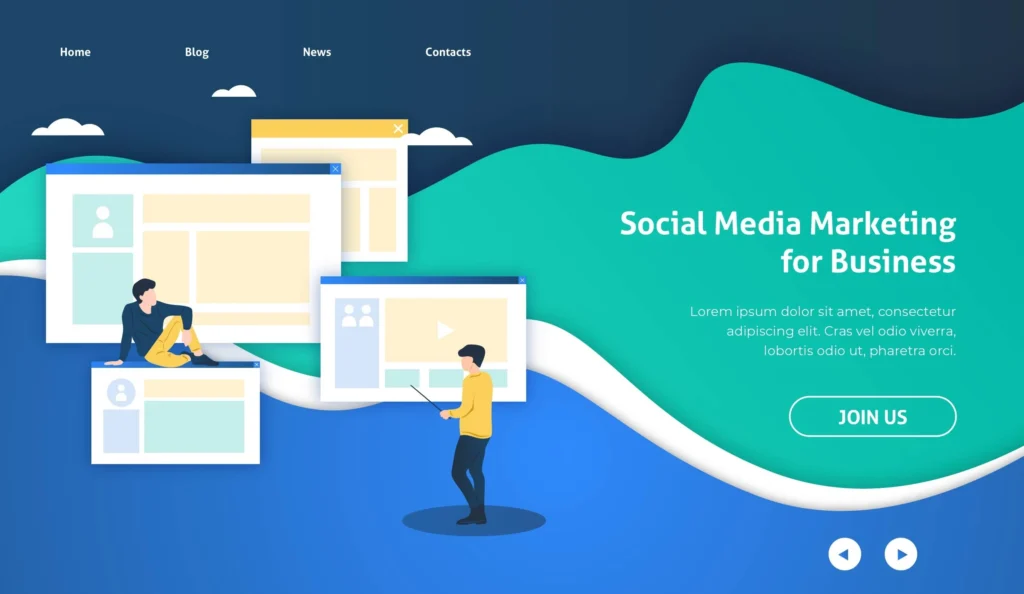Table of Contents
Is 2025 the Right Time to Revamp Your Website? Here's Why.
Planning to revamp your website in 2025? You’re not alone. In today’s fast-paced digital world, your website is more than just a digital business card — it’s your most powerful sales tool, the foundation of your online presence, and often the first impression your brand makes.
However, users now expect more than just basic functionality. They demand fast load times, mobile responsiveness, and a seamless, engaging experience. If your current site is outdated or underperforms, you could be losing trust, traffic, and revenue — often without even realizing it. That’s why many forward-thinking businesses are choosing to revamp their websites in 2025 to stay ahead of the competition and meet rising customer expectations.
🚨 According to recent research:
- 80% of consumers judge a company’s credibility based solely on website design.
89% of customers will switch to a competitor after a poor online experience.
Moreover, with global e-commerce projected to reach $7.4 trillion by 2025, your website must do more than function — it should attract, convert, and scale with your business. Otherwise, an outdated or slow site can lead to high bounce rates, low conversions, and lost credibility.
Whether you’re facing poor engagement, declining SEO rankings, or outdated tech, revamping your website in 2025 is a smart move. It’s not just about visual appeal — instead, it’s about building a faster, smarter, and more scalable experience that aligns with your brand’s growth.
In short, 2025 is the year to act. This guide will explore seven compelling reasons why a website redesign isn’t just beneficial — it’s essential.

1. Your Design Is Outdated and Hurting Trust
First impressions matter—especially online. In a world where users form opinions in milliseconds, your website is often the very first touchpoint potential customers have with your brand. Studies consistently show that nearly 80% of people assess a business’s credibility purely based on its website design. That means outdated layouts, poor visuals, or clunky navigation could be silently damaging your reputation.
Think about it—would you trust a company that looks like it hasn’t updated its website since 2015? Probably not. An old design suggests a lack of innovation, professionalism, and attention to detail. This can lead to higher bounce rates, reduced user engagement, and ultimately, lost revenue.
That’s why it’s critical to revamp your website in 2025—not just for aesthetics, but for performance and perception. A modern redesign allows you to:
- Implement sleek, intuitive layouts that improve usability
- Create a cohesive visual story that builds trust and keeps visitors engaged
- Stay competitive with industry trends and evolving customer expectations
Moreover, design isn’t just about how your site looks—it’s also about how it makes users feel. A fresh, polished website builds confidence, conveys professionalism, and invites users to explore more deeply. Whether you’re a startup or a seasoned brand, investing in a modern design is a strategic move to enhance trust, authority, and conversion potential.
Don’t let outdated visuals be the reason someone chooses your competitor. If you want to make a strong digital impression in a saturated market, revamping your website in 2025 is one of the most impactful decisions you can make.
2. Revamp Your Website in 2025 for Mobile Optimization
In today’s mobile-first world, having just a desktop-friendly website isn’t enough. Most users now browse, shop, and interact with brands on their phones and tablets. In fact, over 60% of global web traffic comes from mobile devices—and that number is still rising.
If your website isn’t fully responsive, or if visitors face tiny buttons, awkward touch navigation, or slow-loading mobile pages, you’re not just offering a poor experience—you’re pushing users toward your competitors.
📉 Did you know?
- 53% of users abandon a site if it takes more than 3 seconds to load.
A bad mobile experience can cut your conversion rate in half.
Why You Should Revamp Your Website in 2025
To stay competitive, you need a site that performs perfectly on mobile. A modern redesign can help you:
- ✅ Make your layout adapt to all screen sizes
- ⚡️ Improve mobile speed with performance-first design
- 🧭 Enhance touch navigation and easy-to-use mobile menus
- 👆 Add features like sticky headers, thumb-friendly buttons, and vertical scrolling
Google Prioritizes Mobile
Google now uses mobile-first indexing, which means your mobile site is what gets ranked in search results. If it performs poorly, your SEO rankings suffer too.
The Bottom Line
Today’s users expect a smooth and easy experience—especially on mobile. If your site is slow, hard to use, or doesn’t work well on phones, people won’t stay. They’ll leave and likely won’t come back.
That’s why 2025 is the right time to revamp your website. A mobile-friendly design can help more users find what they need, take action faster, and enjoy their visit.
Focus on fast loading speeds, easy navigation, and touch-friendly features. When mobile users have a great experience, they’re more likely to turn into loyal customers.
3. Revamp Your Website in 2025 to Fix Poor User Experience That’s Driving Customers Away
A good-looking website isn’t enough. If users can’t find what they need fast, they’ll leave. Bad user experience (UX) — like confusing menus, hard-to-use forms, or slow loading — turns visitors away.
88% of people won’t come back after a bad website experience. Each problem on your site could cost you a customer. They may choose a competitor with a smoother, faster website.
That’s why 2025 is the time to improve your website’s UX. A smart redesign helps by:
- 🧭 Making menus simple and easy to follow
- 📐 Using clear layout and structure
- 🔍 Adding easy-to-use search tools
- 🛒 Making checkout or sign-up steps shorter
- 👥 Testing with real users to fix issues early
When your site is easy to use, people stay longer and take action. Good UX means more time on site, better engagement, and more sales.
4. Revamp Your Website in 2025 to Overcome Outdated Technology Limitations
Technology evolves rapidly, and websites built on outdated platforms or content management systems often lack the functionality, security, and integration capabilities needed to stay competitive in 2025.
An outdated technology stack can lead to:
- Security vulnerabilities that put customer data at risk
- Slow site performance that frustrates users and lowers your SEO rankings
- Limited integration with modern marketing and analytics tools
- Difficulty adding new features or scaling your website
Higher maintenance costs and technical debt
When you revamp your website in 2025, you can move to a modern tech stack that solves these issues. Updated frameworks and CMS platforms deliver faster performance, stronger security, and greater flexibility — all essential for adapting to user expectations and business growth.
A technology-focused website revamp doesn’t just fix what’s broken — it future-proofs your digital presence and sets you up for success in the years ahead.
5. Revamp Your Website in 2025: Why Your SEO Needs an Update
Search engine algorithms have undergone massive changes, with user experience signals now playing a central role in rankings. If your website wasn’t built with modern SEO practices in mind, you’re likely losing ground to competitors, regardless of your content quality.
Google’s Core Web Vitals—measuring loading performance, interactivity, and visual stability—have become crucial ranking factors. Websites that fail to meet these standards face declining organic visibility and traffic.
A comprehensive redesign presents the perfect opportunity to build SEO best practices into the foundation of your site:
- Technical SEO improvements like site structure and page speed
- Schema markup for enhanced search results
- Content reorganization to better address user intent
- Improved internal linking structure
- Mobile optimization aligned with Google’s priorities
These improvements can dramatically increase your organic visibility, driving more qualified traffic to your business without increasing your marketing budget.
6. Revamp Your Website in 2025 to Reflect Your Evolving Business
Businesses aren’t static—they grow, pivot, and evolve. If your website doesn’t accurately reflect your current offerings, target audience, or brand positioning, it’s not serving your business effectively.
Signs your website may be misaligned with your business include:
- Outdated service descriptions or product catalogs
- Messaging that doesn’t resonate with your current audience
- Visual branding that doesn’t match your other marketing materials
- Content that no longer reflects your expertise or focus
- Functionality that doesn’t support your current business model
A strategic redesign ensures your website accurately represents your business today while building flexibility for future growth and changes. This alignment between your digital presence and business reality strengthens your brand and builds customer confidence.
7. Revamp Your Website in 2025 to Stay Ahead of the Competition
In nearly every industry, your competitors are constantly improving their digital presence. If your website hasn’t had a major update in the last 2–3 years, there’s a high chance you’re already falling behind — even if it doesn’t feel that way yet.
Today’s customers expect more than just a static website. They look for:
- Personalized experiences tailored to their needs
- Interactive tools that help them make decisions
- Self-service options for quick and easy actions
- Clear and transparent product or service information
- Seamless experiences across desktop, mobile, and social platforms
When you revamp your website in 2025, you’re not just catching up — you’re setting a new standard. A modern redesign helps you meet (and exceed) customer expectations while keeping up with industry trends. It also gives you the opportunity to highlight your unique strengths and stand out in a crowded market.
Staying still is no longer safe. To stay relevant and competitive, your website needs to evolve with your business and your audience.
When Is the Right Time for a Website Redesign?
Most websites have a functional lifespan of 3-5 years before technology changes, design trends, and business evolution make them obsolete. However, certain warning signs might indicate it’s time for a redesign sooner:
- Declining conversion rates despite steady traffic
- High bounce rates, especially on mobile devices
- Difficulty making content or design updates
- Poor performance in search results for relevant keywords
- Feedback from customers about usability issues
- New business initiatives that your current site can’t support
The right time to redesign isn’t just about age—it’s about results. If your website isn’t delivering the business outcomes you need, waiting to redesign could be costing you valuable opportunities.
Avoiding Common Website Redesign Pitfalls
A successful website redesign in 2025 requires more than just a fresh coat of paint—it demands thoughtful strategy and planning. To ensure your investment pays off, it’s important to avoid these common website redesign mistakes:
Focusing on looks instead of functionality
While visual appeal matters, your website must also be intuitive, responsive, and conversion-focused.Skipping clear business objectives
Every redesign decision should align with your brand goals—whether it’s increasing leads, improving SEO, or enhancing user engagement.Overlooking your content strategy
Even the most stunning design will fall flat if paired with weak or outdated content. Ensure your messaging supports SEO and resonates with your audience.Not testing with real users
User experience isn’t about assumptions. Conduct usability testing to validate your design choices with actual users.Ignoring data and analytics
Before you start redesigning, review website performance metrics. Let data drive your decisions—especially around user behavior, bounce rates, and page speed.
Ready to Transform Your Digital Presence?
Your website isn’t just a marketing expense—it’s an investment in your business’s future. A strategically planned redesign can dramatically improve user experience, strengthen your brand, increase conversions, and give you a competitive edge in 2025 and beyond.
Whether you need a complete overhaul or strategic enhancements to key areas, now is the time to evaluate your digital presence and ensure it’s working as hard as possible for your business.
Remember: in the digital world, standing still is the same as moving backward. Is your website ready for 2025? Revamp your website in 2025 now!
Check it out on our iRevamps Facebook channel for more interesting part.




